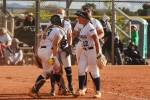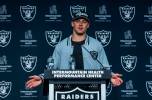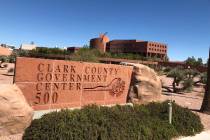Breast cancer patients get help from loved ones
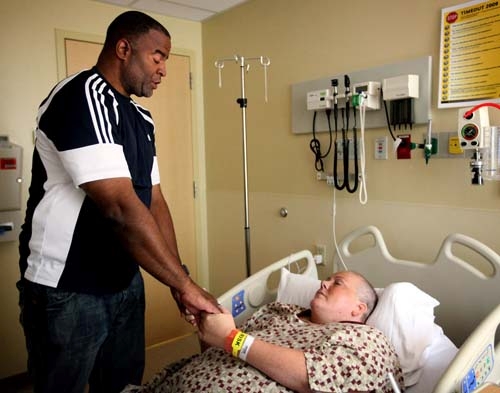

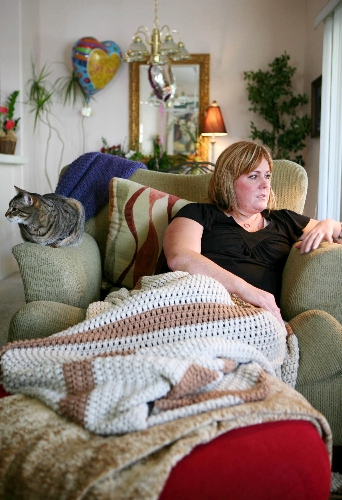

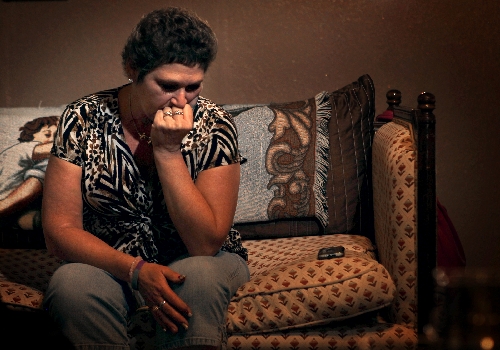
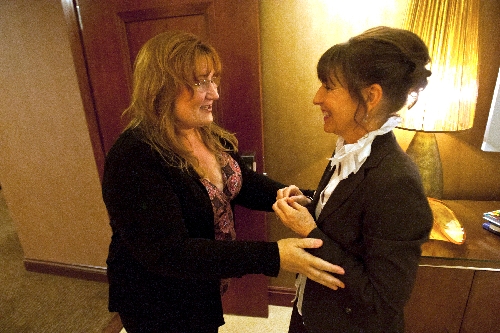


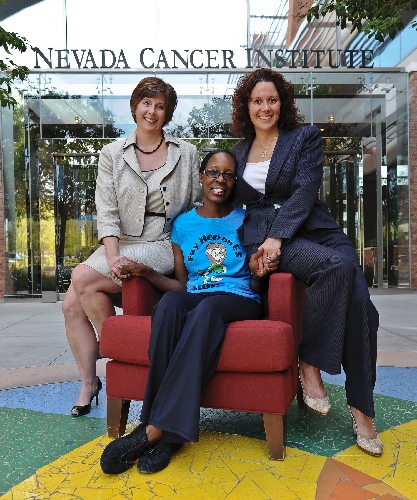
Shannon West Redwine’s bones scream the scream that only she can hear – she describes it as a high-pitched whine accompanying the excruciating pain from chemotherapy-induced stress fractures in her back. She pants like a woman in the last stages of labor.
For this weary 44-year-old woman whose breast cancer has metastasized to her bones, the delivery of a few minutes without suffering would be reason for tears of joy.
The respite can’t come soon enough. The prescribed painkiller cocktail hasn’t really kicked in. She grits her teeth and keeps up the heavy breathing, trying hard not to follow the lead of her bones with screams of her own. She writhes in her hospital bed, hoping to find a position that is comfortable.
Kevin Redwine, a childhood friend who came back into Shannon’s life and married her after learning she had cancer, holds her hand and prays at her bedside.
"Oh, man, back pain is the worst," gasps the former homeless services coordinator. "Can’t wait till we get it under control."
On this first day of Breast Cancer Awareness Month, make no mistake: While success stories in dealing with the disease are plentiful, pain and suffering continue. Some 40,000 Americans are stolen from us each year by a modern-day plague that the best minds in medicine have yet to wipe out.
It is instructive to see how Southern Nevadans cope with a segment of a scourge that too often takes our mothers and grandmothers, sisters and wives, daughters and granddaughters.
Unless you’re a friend or a relative or know them from work, their names do not jump out at you: Shannon West Redwine, Linda Cassone, Renee Hill, Cindy Aguilar, Sharon Fuller, John Craig Carrell. They’re not names from headlines, just hardworking, caring people who help make Southern Nevada livable.
What they also have in common is breast cancer.
Even when treatment appears to have left them cancer free, they will tell you that the passage of time between tests for a recurrence is not for the fainthearted. Somehow, they manage to do their work and show their love for their families with a smile, yet all the time they live with the gnawing sense that the experience that left them praying for more time to live is not over.
Still, these people who are fighting to stay alive reach out to help others.
Given the disease’s prevalence – one in eight women can expect to be diagnosed with it – each of these Southern Nevadans wants to deliver a unique message revolving around the same theme:
Ignorance about breast cancer can be deadly.
IMPROVING NUMBERS
Risk factors for breast cancer haven’t changed much over the years. Advancing age, genetics, radiation exposure, obesity, excessive drinking of alcohol, beginning menstrual periods at a younger age, beginning menopause at an older age, post-menopausal hormone therapy – all may increase the risk of breast cancer.
The good news is that breast cancer rates have been declining by about 2 percent a year since 1999. Most researchers think the drop is linked to a decreased use of menopausal hormone therapy after studies showed a combination of estrogen and progesterone put women at an increased risk of breast cancer.
The death rate for women with the disease has also decreased. From 1990 to 2006, government statistics show that the death rate decreased by 3.2 percent per year among women younger than 50, and by 2 percent per year among women 50 and older. The decline has been attributed to both improvements in breast cancer treatment and early detection afforded by mammography, a low dose X-ray that the National Cancer Institute recommends be done every one to two years after age 40.
Based on the recent data, relative survival rates for women diagnosed with breast cancer are 89 percent at five years after diagnosis, 82 percent after 10 years, and 77 percent after 15 years. If the disease is caught before it spreads, the five-year survival rate is 98 percent, well above the 23 percent survival rate for those who don’t catch the cancer early.
Breast cancer is the second most common cancer among women, after skin cancer, and accounts for nearly one in three cancers diagnosed in American women. The National Cancer Institute estimates that 2.6 million U.S. women with a history of breast cancer were alive in 2008, with more than half diagnosed less than 10 years earlier.
While doctors say more insight into genetics is giving them the opportunity to offer more targeted therapies for breast cancer, it is also true that most patients still go through a treatment regimen that involves surgery, chemotherapy and radiation. Though the process is less disfiguring and less painful than 20 to 30 years ago, some women who endure the care refer to it as "slash, poison and burn."
EARLY DETECTION
Cutting-edge testing allowed Linda Cassone, director of health care benefits at MGM Resorts International, to do without chemotherapy and radiation for breast cancer. Four years ago, she had a double mastectomy followed by breast reconstruction.
Cassone wants to stress the importance of early detection, something she received when the Hope Coach, a mobile mammography unit headquartered at the Nevada Cancer Institute, was brought to the MGM Grand.
She refers to Cynthia Kiser Murphey, a former executive at the MGM Grand who now is president of New York-New York, as "one of my lifesavers."
"She felt it was important for women to get mammograms, so why not bring it to them if you’ve got the chance?" said Cassone, who is 48 and has been cancer free for four years. "That saved my life and made me better at my job. Now, I always go the extra mile for my employees."
The Hope Coach coordinator, Tracie Stuckey-Arana, works with insurance providers at valley businesses to provide the service to women.
"Each digital mammogram only takes 15 minutes," Stuckey-Arana said. "In the last five years, we’ve done 13,000 mammograms with 77 confirmed cases of cancer. We have managed to save lives."
Even though the disease was found only in her left breast, Cassone had the doctor take the other breast as well, surgery that would reduce the chance of cancer occurring in that area by more than 90 percent.
"I wanted to be there for my boy, who was only six at the time. I still worry about a recurrence. How can I not?"
Tears well in her eyes as Cassone shows off an autobiographical paper that her young son Gian wrote for school.
"In first grade I was really skinny. In first grade my mom got breast cancer. The doctors even said I was why she lived, she kept fighting for me. I am glad she is alive. She was fine when I got to second grade. I gained weight and stress."
RISK AMONG MEN
In August 2011, John Craig Carrell got out of the shower in his Henderson home, stretched, and felt a lump on the right side of his chest.
"Is this really a lump?" he asked his wife.
It was, and he got tested. A year’s worth of surgery, chemo and radiation followed the breast cancer diagnosis.
Now cancer free, the retired 73-year-old physicist said he has become an evangelist for men checking themselves for the disease.
Men have a one in 1,000 chance of contracting breast cancer in their lifetime, according to the American Cancer Society. The number of new cases in men has gone from 1,970 to 2,140 over the past year, and deaths among males rose from 390 to 450.
Carrell has never been embarrassed about saying he has a disease that most people associate with women.
"Why should I? Cancer is cancer. You don’t want to die from it."
Carrell, who taught at colleges in Georgia and Illinois, regularly emailed family, friends and science associates across the country about his journey, calling it "Craig’s Cancer Chronicles."
When Carrell went to his urologist to have his prostate checked, he told him about his breast cancer. The urologist was so taken aback, Carrell said, that he said his medical group may start screening men for breast cancer.
"I’ll be in a line at a grocery store or anywhere and bring it up with guys," he said. "I hope I save some lives."
NEW DRUG TREATMENTS
Dr. Heather Allen sat in her Comprehensive Cancer Centers of Nevada office the other day and talked about new drugs that are allowing women with metastatic breast cancer "to live five years or more with a good quality of life."
T–DM1, and several other drugs in development, the oncologist noted, are different from traditional cancer fighters because they consist of powerful poisons linked to proteins called antibodies, which latch onto cancer cells and deliver the poison directly into those cells. Because the poison is not active until it reaches the tumor, side effects are reduced.
Three years ago, Sharon Fuller, a 69-year-old retired nurse suffering from Stage 4 breast cancer, knew she was on death’s doorstep. The cancer had spread to her lymph nodes and liver. Doctors said there was no point in undergoing radiation or surgery.
Then she became part of a T-DM1 trial at Comprehensive.
"Scans show I’ve gotten rid of seven cancerous nodules, including one in my liver," Fuller said as she received the drug in an IV. "I really haven’t had any side effects. … It’s made a believer out of me. … Maybe I’ll be alive until a better drug comes along."
Like many people, Fuller wondered if she would have to go out of town to receive the latest trial drugs.
She did some research and learned about Comprehensive’s affiliation with the renowned UCLA cancer research center.
"It turned out that the latest trials were being done right here," she said. "Do your own homework. Take nothing for granted. You owe it to yourself."
GETTING SUPPORT
Renee Hill felt overwhelmed when she was diagnosed with breast cancer two years ago.
"I had a 13-year-old boy and twin 11-year-old girls, and I was going through a divorce and I had to work," she said. "I didn’t know if I could make it. I wanted to cook for my kids, help them with their homework. But that chemo really takes it out of you."
A kindergarten teacher at Herron Elementary in North Las Vegas, Hill said what helped her manage the ordeal was an understanding school principal and a neighbor, Karen Watnem, who then happened to be a nurse at University Medical Center.
"Karen changed (the dressings on) my wounds after my double mastectomy, helped me monitor tubes," Hill recalled. "She came up with questions for me for doctors and took me to some doctor’s appointments. Sometimes she watched my kids, and sometimes she fed them. And remember, she and her husband have two kids of their own."
At one point after her surgery, Hill remembered that in mid-July she covered her body with two sweaters.
"I didn’t feel feminine anymore," she said. "Karen got those sweaters off me, told me that I’m still a beautiful woman, that I had nothing to be ashamed of. I don’t know how anybody gets through something like this without family and friends for support."
Now cancer free, Hill, 44, always dreads the checkups that could show a recurrence. "I really pray," she said.
Watnem, now director of clinical operations at the University of California, San Diego Cancer Institute, sees Hill when she comes in for checkups.
To Watnem, what she did with Hill was what neighbors do.
"Our kids go to school together and we’re friends," she said. "She needed help. That’s what friends are for."
OTHER OPTIONS
Eighteen months ago, Cindy Aguilar discovered a lump in her breast.
The doctor ordered a mammogram. The radiology report suggested an immediate biopsy.
But when Aguilar went to the breast surgeon that her insurance company suggested, the surgeon ignored it.
"The surgeon said radiologists try to scare people, and then she just drained what she called a cyst," said Aguilar, 55. "She said she was sure it wasn’t cancer. I was relieved but uncomfortable. Why was she ignoring the radiology report?"
The lump was drained on three other occasions. A biopsy was finally done, but her doctor said not to worry about it.
When Aguilar returned to the office, the doctor was out of town. As the biopsy incision was being checked, a nurse said Aguilar’s type of cancer could be problematic.
"I said, ‘I have cancer?’ I started bawling right there," Aguilar said. "They had said they were sure I didn’t have cancer. The nurse became very apologetic and said, ‘I know I shouldn’t have blurted it out like that.’ "
Genetic testing was ordered. Aguilar told her medical team that if she had a mutation in the BRCA1 or BRCA2 gene, she wanted a double mastectomy because that is a serious form of breast cancer that often spreads.
The surgeon ignored her request, she said, and scheduled a lumpectomy on one breast.
Cindy, her husband and their children were furious. It wasn’t long before they scheduled an appointment at Cancer Treatment Centers of America in Phoenix, which markets itself in Las Vegas as being more patient-centered.
"It was totally different there," she said. "It was all about me. I never have to wait. An entire team explained things to me. When I told them what I wanted, my opinion meant something. They are compassionate. They care about patients."
A representative for Cancer Centers said Southern Nevada is the third-fastest growing market for the Phoenix hospital.
"You wouldn’t believe how many people from Las Vegas go there," said Aguilar, who says she feels great since finishing surgery, chemotherapy and radiation. "They even pay my way to come and go on the plane. I think people in Southern Nevada owe it to themselves to check out all their treatment options."
STORY OF HOPE
The medication has begun to take effect on Shannon West Redwine, taking the edge off the pain from the breast cancer that has spread to her bones. She smiled at her husband and visitors from her bed in Sunrise Hospital.
Four years ago when West Redwine, then regional homeless services coordinator for Clark County, discovered a lump in her right breast as she took a shower, she never dreamed she would have to enter a hospital periodically just to manage her pain. Eighteen narcotic pills a day can’t do what an IV drip of Dilaudid does.
Yes, she suspected she had breast cancer – her mother is a 70-year-old breast cancer survivor. But she saw herself moving on quickly from a surgical flesh wound to energetically lead men, women and children out of the gutter and into useful lives. After all, she is the daughter of a highly decorated fighter pilot. Retired Air Force Maj. Gen. W. Thomas West always told her to keep on keepin’ on when you meet adversity.
Now, barely able to move, she discusses how to help others help themselves.
She wants to start a newsletter at Comprehensive Cancer Centers that’s written by and for patients.
"I think something from patients themselves can be really helpful," she said. She laughs, but there’s a tired sadness in her eyes. "I can tell people to have vomit bags in every part of the house so you don’t make a mess."
Her oncologist, Dr. Heather Allen, said the trips to the hospital for pain management are because West Redwine is "refusing to stop trying to make a difference in the world."
Even after her cancer came roaring back a year after a double mastectomy, chemotherapy and radiation, she still coordinated homeless outreach efforts in local jurisdictions and trudged through homeless encampments trying to talk people into shelters.
She finally took a disability retirement in 2010 and soon afterward county officials held a ceremony for the woman who was then in a wheelchair, renaming the shelter for homeless youth at Foremaster Lane and Las Vegas Boulevard after her. Retirement hasn’t kept her from regularly showing up to work with children at the shelter or working as a board member with the Nevada Community Foundation to help veterans.
What has helped keep her positive and as energetic as possible, she said, is the re-entry of Kevin Redwine into her life.
They first met at Nellis Air Force Base when both their dads were in the military. They played on the same softball team as teenagers. Smitten, she sent him a love note with green M&Ms.
"I was too shy to respond," Redwine said recently as he sat in the Henderson condominium where the couple lives.
An operations employee with the Clark County School District, Redwine learned that Shannon was sick through a TV segment that featured Shannon and her mother raising money for breast cancer research.
He phoned, and they talked and laughed about where their lives had taken them. They soon became a couple.
She’ll always remember his proposal: "God doesn’t promise any of us tomorrow, and I would rather spend one day with you than a lifetime with someone else."
They were married in December 2010.
"I had never been married, and now I am blessed with being a wife and mom and grandma from Kevin’s children" from a previous marriage, West Redwine said. "I think my story is a story of hope. Life is not over when you get cancer. In many ways I feel as though mine has just started."
Contact reporter Paul Harasim at pharasim@reviewjournal.com or 702-387-2908.
Breast Cancer AwarenessNews stories, events





